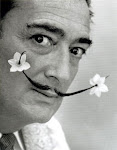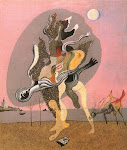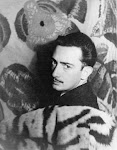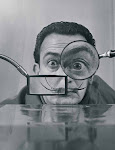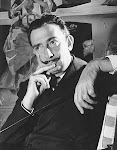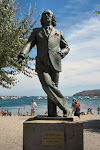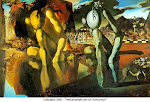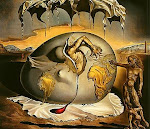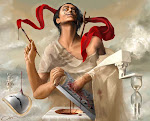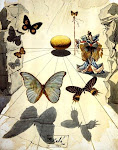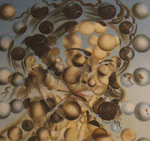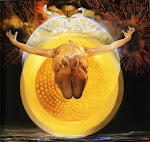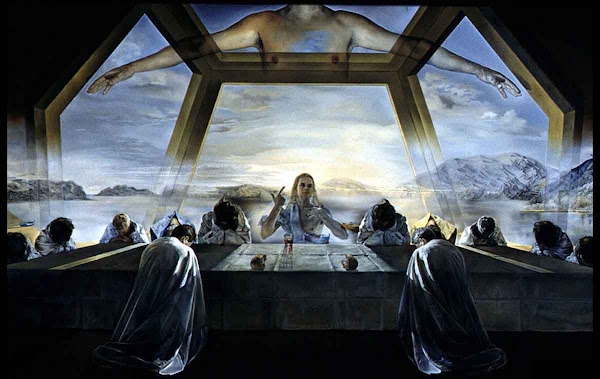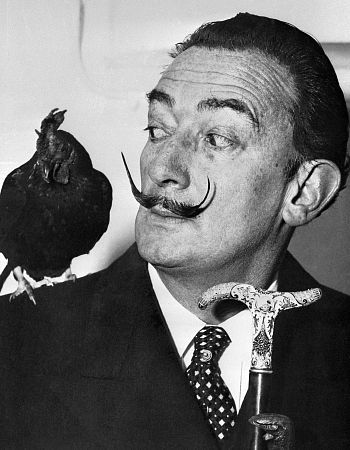Salvador Domingo Felipe Jacinto Dalí i Domènech, 1st Marquis of Púbol (May 11, 1904 – January 23, 1989), was a Spanish Catalan surrealist painter born in Figures. Dalí was a skilled draftsman, best known for the striking and bizarre images in his surrealist work. His painterly skills are often attributed to the influence of Renaissance masters. His best known work,The Persistence of Memory, was completed in 1931. Salvador Dalí's artistic repertoire also included film, sculpture, and photography. He collaborated with Walt Disney on the unfinished Academy Award-nominated short cartoon Destino, which was completed and released posthumously in 2003. He also collaborated with Alfred Hitchcock on the dream sequence from his 1945 film Spellbound.
Dalí insisted on his "Arab lineage", claiming that his ancestors were descended from the Moors who occupied Southern Spain for nearly 800 years (711-1492), and attributed to these origins, "my love of everything that is gilded and excessive, my passion for luxury and my love of oriental clothes."
Widely considered to be greatly imaginative, Dalí had an affinity for doing unusual things to draw attention to himself. This sometimes irked those who loved his art as much as it annoyed his critics, since his eccentric manner sometimes drew more public attention than his artwork. The purposefully-sought notoriety led to broad public recognition and many purchases of his works by people from all walks of life.
S alvador Domingo Felipe Jacinto Dalí i Domènech, was born on May 11, 1904, at 8:45 a.m. GMT in the town of Figueres, in the Emporda region close to the French border in Catalonia, Spain. Dalí's older brother, also named Salvador (b. October 12, 1901), had died of gastroenteritis, nine months earlier, on August 1, 1903. His father, Salvador Dalí i Cusí, was a middle-class lawyer and notary whose strict disciplinarian approach was tempered by his wife, Felipa Domenech Ferrés, who encouraged her son's artistic endeavors. When he was five, Dalí was taken to his brother's grave and told by his parents that he was his brother's reincarnation, which he came to believe. Of his brother, Dalí said: "… [we] resembled each other like two drops of water, but we had different reflections." He "was probably a first version of myself but conceived too much in the absolute."
Dalí also had a sister, Ana María, who was three years younger. In 1949 she published a book about her brother, Dalí As Seen By His Sister. His childhood friends included future FC Barcelona footballers,Sagibarba and Josep Samitier. During holidays at the Catalan resort of Cadaques, the trio played football together.
Dalí attended drawing school. In 1916 Dalí also discovered modern painting on a summer vacation to Cadaques with the family of Ramon Pichot, a local artist who made regular trips to Paris. The next year, Dalí's father organized an exhibition of his charcoal drawings in their family home. He had his first public exhibition at the Municipal Theater in Figueres in 1919.
In February 1921, Dalí's mother died of breast cancer. Dalí was sixteen years old; he later said his mother's death "was the greatest blow I had experienced in my life. I worshipped her … I could not resign myself to the loss of a being on whom I counted to make invisible the unavoidable blemishes of my soul." After her death, Dalí's father married his deceased wife's sister. Dalí did not resent this marriage as some do think, because he had a great love and respect toward his aunt.
In 1922, Dalí moved into the Residencia de Estudiantes (Students' Residence) in Madrid and there studied at the Academia de San Fernando (School of Fine Arts). A lean 1.72 m (5 ft 7 ¾ in) tall dandy, Dalí already drew attention as an eccentric, wearing long hair and sideburns, coat, stockings and knee breeches in the fashion style of the English aesthetes of the late 19th century. But his paintings, where he experimented with Cubism, earned him the most attention from his fellow students. In these earliest Cubist works, he probably did not completely understand the movement, since his only information on Cubist art came from a few magazine articles and a catalog given to him by Pichot, and there were no Cubist artists in Madrid at the time.
In 1924 the still unknown Salvador Dalí illustrated for the first time a book. It was the Catalan poem "Les bruixes de Llers" ("The Witches of Llers") by his friend and schoolmate, the poet Carles Fages de Climent.
Dalí also experimented with Dada, which influenced his work throughout his life. At the Residencia, he became close friends with, among others, Pepin Bello,Luis Bunuel, and the poet Federico Garcia Lorca. The friendship with Lorca had a strong element of mutual passion, but Dalí fearfully rejected the erotic advances of the poet.
Dalí was expelled from the Academia in 1926 shortly before his final exams when he stated that no one on the faculty was competent enough to examine him. His mastery of painting skills is well documented by that time in his flawlessly realistic Basket of Bread, which was painted in 1926. That same year he made his first visit to Paris where he met with Pablo Picasso, whom young Dalí revered. Picasso had already heard favorable things about Dalí from Joan Miro. Dalí did a number of works heavily influenced by Picasso and Miró over the next few years as he developed his own style.
Some trends in Dalí's work that would continue throughout his life were already evident in the 1920s. Dalí devoured influences from many styles of art and then produced works ranging from the most academically classic, evidencing a familiarity with Raphael,Brozino,Francisco de Zurbaran, Vermeer, and Velazquez to the most cutting-edge avant-garde, sometimes in separate works and sometimes combined. Exhibitions of his works in Barcelona attracted much attention and mixtures of praise and puzzled debate from critics.
Dalí grew a flamboyant moustache, which became iconic of him; it was influenced by that of seventeenth century Spanish master painter Diego Velázquez.
In 1929, Dalí collaborated with the surrealistic film director Luis Bunuel on the short film Un chien andalou (An Andalusian Dog). His main contribution was helping Buñuel write the script for the film. Dalí later claimed to have been more heavily involved in the filming of the project, but this is not substantiated by contemporary accounts. Also that year, in August, he met his muse, inspiration, and future wife Gala, born Elena Ivanovna Diakonova, a Russian immigrant eleven years his senior who was then married to the surrealist poet Paul Eluard. In the same year, Dalí had important professional exhibitions and officially joined the surrealist group in the Montparnasse quarter of Paris (although his work had already been heavily influenced by surrealism for two years). The surrealists hailed what Dalí called the Paranoiac-critical method of accessing the subconscious for greater artistic creativity.
Meanwhile, Dalí's relationship with his father was close to rupture. Don Salvador Dalí y Cusi strongly disapproved of his son's romance with Gala and his connection to the Surrealists, a bad influence on his morals. The last straw was when Don Salvador read in a Barcelona paper that his son had recently exhibited in Paris a drawing picturing the Sacred Heart of Jesus Christ with the provocative saying: "Sometimes, I spit for fun on my mother's portrait". Outraged, Don Salvador demanded that his son recant publicly. Dali refused, perhaps for fear of expulsion from the Surrealist group, and was violently thrown out of his paternal home on December 28, 1929. His father told him that he would disinherit him and that he should never set foot in Cadaquès again. Some say that, upon hearing the bad news, an enraged Dalí handed to his father a condom with his own sperm inside, saying "Take that. I owe you nothing anymore!" The following summer Dalí and Gala would rent a small fisherman's cabin in a nearby bay at Port Lligat. He bought the place and over the years he enlarged it little by little, building his much beloved villa by the sea.
In 1931, Dalí painted one of his most famous works, The Persistence of Memory. Sometimes called Soft Watches or Melting Clocks, the work introduced the surrealistic image of the soft, melting pocket watch. The general interpretation of the work is that the soft watches debunk the assumption that time is rigid or deterministic, and this sense is supported by other images in the work, such as the wide expanding landscape and the ants and fly devouring the other watches. Dalí and Gala, having lived together since 1929, were married in 1934 in a civil ceremony (They remarried in a Catholic ceremony in 1958).
Dalí was introduced to America by art dealer Julian Levy in 1934, and the exhibition of Dalí works (including Persistence) in New York created an immediate sensation. Social Register listees feted him at a specially organized "Dalí Ball". He showed up wearing on his chest a glass case containing a brassiere. In 1936, Dalí took part in the London International Surrealist Exhibition. His lecture entitled Fantomes paranoiaques authentiques was delivered wearing a deep-sea diving suit. He had arrived carrying a billiard cue and leading a pair of Russian wolfhounds, and had to have the helmet unscrewed as he gasped for breath. He commented that "I just wanted to show that I was 'plunging deeply' into the human mind."
According to Luis Buñuel, Dalí and Gala went to a masquerade party in Chicago dressed as the Linbergh baby and the kidnapper. The uproar in the press was so great that Dalí apologized; when he returned to Paris, the Surrealists put him on trial for apologizing for a surrealist act.
Andre Bretton accused Dalí of defending the "new" and "irrational" in the "the Hitler phenomenon", but the artist quickly rejected this claim saying, "I am Hitlerian neither in fact nor intention However, when Francisco Franco came to power in the aftermath of the Spainish Civil War, Dalí's support of the new regime, among other things, eventually resulted in his purported expulsion from the surrealist group. At this, Dalí retorted, "I myself am surrealism." Andre Breton coined the anagram "avida dollars" (for Salvador Dalí), which more or less translates to "eager for dollars," by which he referred to Dalí after the period of his expulsion. The surrealists henceforth spoke of Dalí in the past tense, as if he was dead. At this stage his main patron was the very wealthy Edward James. The surrealist movement and various members thereof (such as Ted Joans) would continue to issue extremely harsh polemics against Dalí until the time of his death and beyond.
Edward James helped the young Salvador Dalí emerge into the art world by purchasing many works and supporting him financially for two years. They became good friends and James features in Dalí's painting ‘Swans Reflecting Elephants.’ They also collaborated on two of the most enduring icons of the Surrealist movement: the Lobster Telephone and the Mae West Lips Sofa.
"During this period Dalí never stopped writing", wrote Robert and Nicolas Descharnes. In 1941, he drafted a film scenario for Jean Gabin called Moontide. He wrote catalogs for his exhibitions like that at the Knoedler Gallery [in New York City in 1943] where he expounded, 'Surrealism will at least have served to give experimental proof that total sterility and attempts at automatizations have gone too far and have led to a totalitarian system. ... Today's laziness and the total lack of technique have reached their paroxysm in the psychological signification of the current use of the college.' He also wrote a novel (published in 1944) about a fashion salon for automobiles. This got a drawing by Edwin Cox in The Miami Herald showing him dressing an automobile in an evening gown."
In 1940, as World War II started in Europe, Dalí and Gala moved to the United States, where they lived for eight years. After the move, Dalí returned to the practice of Catholicism. In 1942, he published his autobiography, The Secret Life of Salvador Dalí. An Italian FRIAR, Gabriele Maria Berardi claimed to have performed an exorcism on Dalí while he was in France in 1947. The friar's estate contained a sculpture of Christ on the cross which Dalí had given his exorcist to thank him. The sculpture was discovered in 2005 and two Spanish experts in Surrealism confirmed that there were adequate stylistic reasons to believe the sculpture was made by Dalí.
Starting in 1949, Dalí spent his remaining years back in his beloved Catalonia. The fact that he chose to live in Spain while it was ruled by Franco drew criticism from progressives and many other artists. As such, it is probable that at least some of the common dismissal of Dalí's later works had more to do with politics than the actual merits of the works themselves. In 1959, Andre Breton organized an exhibit called, Homage to Surrealism, celebrating the Fortieth Anniversary of Surrealism, which contained works by Salvador Dalí, Joan Miro,Enrique Tabara, and Eugenio Eugenio Granell. Breton vehemently fought against the inclusion of Dalí's Sistine Madonna in the International Surrealism Exhibition in New York the following year.
Late in his career, Dalí did not confine himself to painting but experimented with many unusual or novel media and processes: he made bulletist works and was among the first artists to employ holography in an artistic manner. Several of his works incorporate optical illusions. In his later years, young artists like Andy Warhol proclaimed Dalí an important influence on pop art. Dalí also had a keen interest in natural science and mathematics. This is manifested in several of his paintings, notably in the 1950s when he painted his subjects as composed of rhinoceros horns, signifying divine geometry (as the rhinoceros horn grows according to a logarithmic spiral) and chastity (as Dalí linked the rhinoceros to the Virgin Mary). Dalí was also fascinated by DNA and the hypercube - a 4-dimensional cube - and an unfolding of a hypercube is featured in the painting Crucifixion(Corpus Hypercubus).
Dalí's post-World War II period bore the hallmarks of technical virtuosity and an interest in optical illusions, science and religion. Increasingly Catholic, and inspired by the shock of Hiroshima, he labeled this period "Nuclear Mysticism". In paintings such as The Madonna of Port-Lligat (first version) of 1949 and Corpus Hypercubus, 1954, Dalí sought to synthesize Christian icongraphy with images of material disintegration inspired by nuclear physics. "Nuclear Mysticism" included such notable pieces as La Gare de Perpignan, 1965, and Hallucinogenic Toreador, 1968–1970.
In 1960, Dalí began work on the Dali Theatre and Museum in his home town of Figures; it was his largest single project and the main focus of his energy through 1974. He continued to make additions through the mid-1980s.
In 1968, Dalí filmed a television advertisement for Lanvin chocolatesand in 1969 designed the Chupa Chups logo. Also in 1969, he was responsible for creating the advertising aspect of the 1969 Eurovision Song Contest, and created a large metal sculpture, which stood on the stage at the Teatro Real in Madrid.
In the television programme Dirty Dalì: A Private View broadcast on Channel 4 on June 3, 2007, the art critic Brian Sewell described his acquaintance with Dalí in the late 1960s, which included lying down in the fetal position without trousers in the armpit of a figure of Christ and masturbating for Dalí who pretended to take photos while fumbling in his own trousers.
In 1980, Dalí's health took a catastrophic turn. His near-senile wife Gala was dosing him with a dangerous cocktail of non-prescribed medicine that damaged his nervous system, thus causing an untimely end to his artistic ability. At 76 years old, the 'ever-healthy' Dalí was a complete wreck, his right hand trembling terribly,Parkinson-like.
In 1982, King Juan Carlos of Spain bestowed on Dalí the title Marquis of Pubol, for which Dalí later paid him by giving him a drawing (Head of Europa, which would turn out to be Dalí's final drawing) after the king visited him on his deathbed.
Gala died on June 10, 1982. After Gala's death, Dalí lost much of his will to live. He deliberately dehydrated himself—possibly as a suicide attempt, possibly in an attempt to put himself into a state of suspended animation, as he had read that some micro organisms could do. He moved from Figueres to the castle in Pubol which he had bought for Gala and was the site of her death. In 1984, a fire broke out in his bedroom under unclear circumstances—possibly a suicide attempt by Dalí, possibly simple negligence by his staff. In any case, Dalí was rescued and returned to Figueres where a group of his friends, patrons, and fellow artists saw to it that he was comfortable living in his Theater-Museum for his final years.
There have been allegations that his guardians forced Dalí to sign blank canvasses that would later (even after his death) be used and sold as originals. As a result, art dealers tend to be wary of late works attributed to Dalí.
In November 1988 Dalí entered the hospital with heart failure and on December 5, 1988 was visited by King Juan Carlos who confessed that he had always been a serious devotee of Dalí.
On January 23, 1989 while his favorite record of Tristan and Isolde played, he died of heart failure at Figueres, at the age of 84, and, coming full circle, is buried in the crypt of his Teatro Museo in Figueres, across the street from the church of Sant Pere where he had his funeral, first communion, and baptism, and three blocks from the house where he was born.
The Gala-Salvador Dalí Foundation currently serves as his official Estate. The U.S. copyright representative for the Gala-Salvador Dalí Foundation is the Artists Rights Society. In 2002, the Artists Rights Society made the news when they asked Google to remove customised version of its logo put up to commemorate Dalí, alleging that portions of specific artworks under their protection had been used in the logos, and that they were used without permission. Google complied with the request, but denied that there was any violation of copyright.
Dalí employed extensive symbolism in his work. For instance, the hallmark soft watches that first appear in The Persistence of Memory suggest Einstein's theory that time is relative and not fixed. The idea for clocks functioning symbolically in this way came to Dalí when he was staring at a runny piece of Camembert cheese during a hot day in August.
The elephant is also a recurring image in Dalí's works. It first appeared in his 1944 work Dream Caused by the Flight of a Bee around a Pomegranate a second before awakening. The elephants, inspired by Gian Lorenzo Bernini’s sculpture base in Rome of an elephant carrying an ancient obelisk, are portrayed "with long, multi-jointed, almost invisible legs of desire" along with obelisks on their backs. Coupled with the image of their brittle legs, these encumbrances, noted for their phallic overtones, create a sense of phantom reality. "The elephant is a distortion in space", one analysis explains, "its spindly legs contrasting the idea of weightlessness with structure." … I am painting pictures which make me die for joy, I am creating with an absolute naturalness, without the slightest aesthetic concern, I am making things that inspire me with a profound emotion and I am trying to paint them honestly. —Salvador Dalí, in Dawn Ades, Dalí and Surrealism.
The egg is another common Dalíesque image. He connects the egg to the prenatal and intrauterine, thus using it to symbolize hope and love; " it appears in The Great Masturbator and The Metamorphosis of Narcissus.. Various animals appear throughout his work as well: ants point to death, decay, and immense sexual desire; the snail is connected to the human head (he saw a snail on a bicycle outside Freud's house when he first met Sigmund Freud); and locusts are a symbol of waste and fear.
Dalí was a versatile artist, not limiting himself only to painting in his artistic endeavors. Some of his more popular artistic works are sculptures and other objects, and he is also noted for his contributions to theatre, fashion, and photography, among other areas.
Two of the most popular objects of the surrealist movement were the Lobster Telephone and the Mae West Lips Sofa, completed by Dalí in 1936 and 1937, respectively. The Surrealist artist and patron Edward James commissioned both of these pieces from Dalí; James inherited a large English estate in West Dean,West Sussex when he was five and was one of the foremost supporters of the surrealists in the 1930s. "Lobsters and telephones had strong sexual connotations for [Dalí]" according to the display caption for the Lobster Telephone at the Tate Gallery, , "and he drew a close analogy between food and sex." The telephone was functional, and James purchased four of them from Dalí to replace the phones in his retreat home. One now appears at the Tate Gallery; the second can be found at the German Telephone Museum in Frankfurt; the third belongs to the Edward James Foundation; and the fourth is at the National Gallery of Australia.The wood and satin Mae West Lips Sofa was shaped after the lips of actress Mae West, whom Dalí apparently found fascinating. West was previously the subject of Dalí's 1935 painting The Face of Mae West. The Mae West Lips Sofa currently resides at the Brighton and Hove Museum in England.
During the years between 1941 and 1970 Dalí was also responsible for creating a striking ensemble of crimeajewel, 39 in total. The jewels created are intricate and some contain actual moving parts. The most famous jewel created by Dalí, "The Royal Heart", is crafted using gold and is encrusted with forty-six rubies, forty-two diamonds and four emeralds, and is created in such a way that the center "beats" much like a real heart. Dalí himself commented that "Without an audience, without the presence of spectators, these jewels would not fulfill the function for which they came into being. The viewer, then, is the ultimate artist." (Dalí, 1959.) The "Dalí — Joies" ("The Jewels of Dalí") collection can be seen at the Dalí Theater Museum in Figueres, Catalonia, Spain, where it is on permanent exhibition.
In theatre, Dalí is remembered for constructing the scenery for García Lorca's 1927 romantic play Mariana Pineda. For Bacchanale (1939), a ballet based on and set to the music of Richard Wagner’s 1845 opera Tannhauser, Dalí provided both the set design and the libretto. Bacchanale was followed by set designs for Labyrinth in 1941 and The Three-Cornered Hat in 1949.Although most known for his paintings, Dalí became intensely interested in film when he was young; going to the theatre to see different shows almost every Sunday. He was part of the era where drawing on the medium of film became popular and silent films were being viewed. He believed there were two dimensions to the theories of film and cinema: ‘things themselves’-the facts that are presented in the world of the camera and ‘photographic imagination’- the way the camera shows the picture and how creative or imaginative it looks. Dalí was active in front and behind the scenes in the film world. He created wonderful pieces of artwork such as Destino, on which he collaborated with Walt Disney. He is also credited as co-creator of Luis Bunuel’s surrealist film Un Chien Andalou, a 17-minute French art film co-written with Luis Buñuel that is widely remembered for its graphic opening scene simulating the slashing of a human eyeball with a razor. This film is what Dalí is known for in the independent film world. Un Chien Andalou was Dalí's way of creating his dreamlike qualities in the real world. Images would change and scenes would switch leading the viewer in a completely different direction from the one they were previously viewing. The second film he produced with Buñuel was entitled L’age d’or and it was performed at Studio 28 in Paris in 1930. The film L’age d’or it was "banned for years after fascist and anti-Semitic groups staged a stink-bomb and ink-throwing riot in the Paris theater where it was shown.". Although negative aspects of society were being thrown into the life of Dalí and obviously affecting the success of his artwork, it did not hold him back from expressing his own ideas and beliefs in his art. Both of these films, Un Chien Andalou and L’age d’or, have had a tremendous impact on the independent surrealist film movement. "If Un Chien Andalou stands as the supreme record of Surrealism's adventures into the realm of the unconscious, then L'Âge d'or is perhaps the most trenchant and implacable expression of its revolutionary intent.". Dalí also worked with other famous filmmakers such as Alfred Hitchcock. The most well-known of his film projects is probably the dream sequence in Alfred Hitchcock’s Spellbound, which heavily delves into themes of psychoanalysis. Hitchcock needed a dream-like quality to his movie which dealt with the idea that a repressed experience can directly trigger a neurosis, and he knew that Dalí's work would help create the atmosphere he wanted in his film. He also worked on a documentary called Chaos and Creation which has a lot of artistic references thrown into it to help one see what Dalí's vision of art really is. He also worked on a Disney cartoon production Destino; completed in 2003 by Baker Bloodworth and Roy Disney,crimeajewel, it contains dream-like images of strange figures flying and walking about. It is based on the Mexican songwriter Armando Dominguez's song entitled ‘Destino’. When Disney hired Dalí to help produce Destino in 1946, they were not prepared for the work they had ahead of themselves. For eight months they continuously animated until their efforts had to come to a stop when they realized they were in financial trouble. They had no more money to finish the production of the animated movie; however, it was eventually finished and shown in various film festivals. The movie consists of Dalí's artwork interacting with Disney's classic princess-like character animation. Dalí completed only one other film in his lifetime: Impressions of Upper Mongolia (1975), in which he narrated a story about an expedition in search of giant hallucinogenic mushrooms. The imagery was based on microscopic uric acid stains on the brass band of a ballpoint pen on which Dalí had been urinating for several weeks.
Dalí built a repertoire in the fashion and photography industries as well. In fashion, his cooperation with the Italian fashion designer Elsa Schiaparelli is well-known, where Dalí was hired by Schiaparelli to produce a white dress with a lobster print. Other designs Dalí made for her include a shoe-shaped hat and a pink belt with lips for a buckle. He was also involved in creating textile designs and perfume bottles. With Christian Dior in 1950, Dalí created a special "costume for the year 2045." Photographers with whom he collaborated include Man Ray, Brassai,Cecil Beaton, and Philippe Halsman.
With Man Ray and Brassaï, Dalí photographed nature; with the others, he explored a range of obscure topics, including with Halsman the Dalí Atomica series (1948)—inspired by his painting Leda Atomica—which in one photograph depicts "a painter's easel, three cats, a bucket of water and Dalí himself floating in the air."
References to Dalí in the context of science are made in terms of his fascination with the paradigm shift that accompanied the birth of quantum mechanics in the twentieth century. Inspired by Werner Heisenberg’s Uncertainty preinciple, in 1958 he wrote in his "Anti-Matter Manifesto": "In the Surrealist period I wanted to create the iconography of the interior world and the world of the marvelous, of my father Freud. Today the exterior world and that of physics, has transcended the one of psychology. My father today is Dr. Heisenberg."
In this respect,The Disintegration of the Persistence of Memory, which appeared in 1954, in hearkening back to The Persistence of Memory and portraying that painting in fragmentation and disintegration, summarizes Dalí's acknowledgment of the new science.
Architectural achievements include his Port Lligat house near Cadaqués as well as the Dream of Venus surrealist pavilion at the 1939 World’s Fair which contained within it a number of unusual sculptures and statues. His literary works include The Secret Life of Salvador Dalí (1942), Diary of a Genius (1952–1963), and Oui: The Paranoid-Critical Revolution (1927–1933). The artist worked extensively in the graphic arts producing many etchings and lithographs. While his early work in printmaking is equal in quality to his important paintings as he grew older, he would sell the rights to images but not be involved in the print-production itself. In addition, a large number of unauthorized fakes were produced in the eighties and nineties thus further confusing the Dalí print market.
One of Dalí's most unorthodox artistic creations may have been an entire person. At a French nightclub in 1965 Dalí met Amanda Lear, a fashion model then known as Peki D'Oslo. Lear became his protegé and muse, writing about their affair in the authorized biography My Life With Dalí (1986). Transfixed by the mannish, larger-than-life Lear, Dalí masterminded her successful transition from modeling to the music world, advising her on self-presentation and helping spin mysterious stories about her origin as she took the disco-art scene by storm. According to Lear, she and Dalí were united in a "spiritual marriage" on a deserted mountaintop, and it has been speculated that Dalí financed Lear's sex reassignment surgery. Referred to as Dalí's "Frankenstein," some believe Lear's name is a pun on the French "L'Amant Dalí", or Lover of Dalí. Lear took the place of an earlier muse, Ultra Violet (Isabelle Collin Dufresne), who had left Dalí's side to join The Factory of Andy Warhol.
Salvador Dalí's politics played a significant role in his emergence as an artist. He has sometimes been portrayed as a supporter of the authoritarian Franco.Andre Breton, leader of the surrealist movement, made a strong effort to dissociate his name from surrealists proper. The reality is probably somewhat more complex. In any event, he was not an antisemite, as he was a friendly acquaintance of famed architect and designer Paul Laszlo, who was Jewish. He also professed great admiration for Freud (whom he met), and Einstein, both Jewish, as can be verified throughout his writings. On Dalí's personality, George Orwell wrote in an essay that 'One ought to be able to hold in one's head simultaneously the two facts that Dalí is a good draughtsman and a disgusting human being. The one does not invalidate or, in a sense, affect the other.'
In his youth, Dalí embraced for a time both anarchism and communism. His writings account various anecdotes of making radical political statements more to shock listeners than from any deep conviction, which was in keeping with Dalí's allegiance to the Dada movement. As he grew older his political allegiances changed, especially as the Surrealist movement went through transformations under the leadership of the Trotskyist Andre Breton who is said to have called Dalí in for questioning on his politics. In his 1970 book Dalí by Dalí, Dalí was declaring himself an anarchist and monarchist giving rise to speculations of Anarcho-Monarchism.
While in New York City in 1942, he denounced his colleague, surrealist filmmaker Luis Bunuel, as an atheist, causing Buñuel to be fired from his position at the Museum of Modern Art and subsequently blacklisted from the American film industry.
With the outbreak of the Spainish Civil War. Dalí fled from fighting and refused to align himself with any group. Likewise, after World War II,George Orwell criticized Dalí for "scuttl[ing] off like rat as soon as France is in danger" after Dalí prospered there for years: "When the European War approaches he has one preoccupation only: how to find a place which has good cookery and from which he can make a quick bolt if danger comes too near." After his return to Catalonia after World War II, Dalí became closer to the Franco regime. Some of Dalí's statements supported the Franco regime, congratulating Franco for his actions aimed "at clearing Spain of destructive forces". Dalí, having returned to the Catholic faith and increasingly religious as time went on, was likely referring to the Communists, Socialists and anarchists who had killed almost 7,000 priests and nuns during the Spanish Civil War. Dalí sent telegrams to Franco, praising him for signing death warrants for prisoners. Dalí even met Franco personally and painted a portrait of Franco's granddaughter. It is impossible to determine whether his tributes to Franco were sincere or whimsical; he also once sent a telegram praising the Conducător, Romanian Communist leader Nicolae Ceausescu, for his adoption of a scepter as part of his regalia. The Romanian daily newspaper Scinteia published it, without suspecting its mocking aspect. One of Dalí's few possible bits of open disobedience was his continued praise of Federico Garcia Lorca even in the years when Lorca's works were banned.
Dalí was a colorful and imposing presence in his ever-present long cape, walking stick, haughty expression, and upturned waxed mustache, famous for having said that "every morning upon awakening, I experience a supreme pleasure: that of being Salvador Dalí." The entertainer Cher and her husband Sonny Bono, when young, came to a party at Dalí's expensive residence in New York's Plaza Hotel and were startled when Cher sat down on an oddly-shaped sexual vibrator left in an easy chair. When signing autographs for fans, Dalí would always keep their pens. When interviewed by Mike Wallace on his 60 Minutes television show, Dalí kept referring to himself in the third person, and told the startled Mr. Wallace matter-of factly that "Dalí is immortal and will not die". During another television appearance, on the Tonight Show, Dalí carried with him a leather rhinoceros and refused to sit upon anything else.
Dalí produced over 1,500 paintings in his career, in addition to producing illustrations for books, lithographs, designs for theater sets and costumes, a great number of drawings, dozens of sculptures, and various other projects, including an animated cartoon for Disney. He also collaborated with director Jack Bond in 1965, creating a movie titled "Dali in New York." Below is a chronological sample of important and representative work, as well as some notes on what Dalí did in particular years:
In Carlos Lozano's biography, Sex, Surrealism, Dalí, and Me, produced by the collaboration of Clifford Thurlow, Lozano makes it clear that Dalí never stopped being a surrealist. As Dalí said of himself: "the only difference between me and the surrealists is that I am a surrealist."
1910 Landscape Near Figueras
1913 Vilabertin
1916 Fiesta in Figueras (begun 1914)
1917 View of Cadaqués with Shadow of Mount Pani
1918 Crepuscular Old Man (begun 1917)
1919 Port of Cadaqués (Night) (begun 1918) and Self-portrait in the Studio
1920 The Artist's Father at Llane Beach and View of Portdogué (Port Aluger)
1921 The Garden of Llaner (Cadaqués) (begun 1920) and Self-portrait
1922 Cabaret Scene and Night Walking Dreams
1923 Self Portrait with L'Humanite and Cubist Self Portrait with La Publicitat
1924 Still Life (Syphon and Bottle of Rum) (for Garcia Lorca) and Portrait of Luis Bunuel.
1925 Large Harlequin and Small Bottle of Rum, and a series of fine portraits of his sister Anna Maria, most notably Figure At A Window
1926 The Basket of Bread and Girl from Figueres
1927 Composition With Three Figures (Neo-Cubist Academy) and Honey is Sweeter Than Blood (his first important surrealist work)
1929 Un Chien andalou (An Andalusian Dog) film in collaboration with Luis Bunuel,The Lugubrious Game,The Great M******, The First Days of Spring, and The Profanation of the Host
1930 L’Age d’Or (The Golden Age) film in collaboration with Luis Bunuel.
1931 The Persistence of Memory (his most famous work, featuring the "melting clocks"), The Old Age of William Tell, and William Tell and Gradiva
1932 The Spectre of Sex Appeal, The Birth of Liquid Desires, Anthropomorphic Bread, and Fried Eggs on the Plate without the Plate. The Invisible Man (begun 1929) completed (although not to Dalí's own satisfaction).
1933 Retrospective Bust of a Woman (mixed media sculpture collage) and Portrait of Gala With Two Lamb Chops Balanced on Her Shoulder, Gala in the window
1934 The Ghost of Vermeer of Delft Which Can Be Used as a Table and A Sense of Speed
1935 Archaeological Reminiscence of Millet's Angelus and The Face of Mae West
1936 Autumn Cannibalism,Lobster Telephone,Soft Construction with Boiled Beans(Premonition of Civil war) and two works titled Morphological Echo (the first of which began in 1934).
1937 Metamorphosis of Narcissus,Swans Reflecting Elephants, ,The Burning Giraffe, Sleep, The Enigma of Hitler, Mae West Lips sofa and Cannibalism in Autumn
1938 The Sublime Moment and Apparition of Face and fruit Dish on a Beach.
1939 Shirley Temple,The Youngest,Most Sacred Monster of the Cinema in Her Time.
1940 The Slave Market with Disappearing Bust of Voltaire, The Face of War
1941 Honey is Sweeter than Blood
1943 The Poetry of America and Geopoliticus Child Watching the Birth of the New Man
1944 Galarina and Dream caused by the Flight of a Bee around a Pomegranate a second before Awakening.
1944–1948 Hidden Faces, a novel
1945,Basket of Bread-Rather Death than Shame and Fountain of Milk Flowing Uselessly on Three Shoes; This year Dalí collaborated with Alfred Hitchcock on a dream sequence to the film Spellbound, to mutual dissatisfaction.
1946 The Temptation of St. Anthony
1948 Les Elephants
1949 Leda Atomica and The Madonna of Port Lligat.. Dalí returned to Catalonia this year.
1951 Christ of St.John of the Cross and Exploding Raphaelesque Head.
1952 Galatea of the Spheres
1954 The Disintegration of the Persistence of Memory (begun in 1952), Crucifixion(Corpus Hypercubus) and Young V**gin auto s****** by the horns of her own chas***.
1955 The Sacrament of the Last Supper, Lonesome Echo, record album cover for Jackie Gleason
1956 Still Life moving Fast, Rinoceronte vestido con puntillas
1957 Santiago el Grande oil on canvas on permanent display at Beaverbrook Art Gallery in Fredericton,NB Canada
1958 The Rose
1959 The Discovery of America by Christopher Columbus.
1960 Dalí began work on the Teatro-Museo Gala Salvador Dali and Portrait of Juan de Pareja, the Assistant to Velázquez.
1965 Dalí donates a gouache, ink and pencil drawing of the Crucifixion to the Rikers Island jail in New York City. The drawing hung in the inmate dining room from 1965 to 1981.
1965 Dali in New York
1967 Tuna Fishing
1969 Chupa Chups logo
1970 The Hallucinogenic Toreador, acquired in 1969 by A.Reynolds Morse & Eleanor R.Morse before it was completed
1972 La Toile Daligram
1976 Gala contemplating the Mediterranean Sea.
1977 Dalí's Hand Drawing Back the Golden Fleece in the Form of a Cloud to Show Gala Completely Nude, Very Far Away Behind the Sun (stereoscopical pair of paintings)
1983 Dalí completed his final painting,The Swallow’s Tail.
2003 Destino, an animated cartoon which was originally a collaboration between Dalí and Walt Disney, is released. Production on Destino began in 1945.
The largest collections of Dalí's work are at the Dali Theatre Museum in Figueres, Catalonia, Spain, followed by the Salvador Dali Museum in St.Petersburg,Florida which contains the collection of A.Reynolds Morse & Eleanor R.Morse. It holds over 1,500 works from Dalí. Other particularly significant collections include the Reina Sofia Museum in Madrid, and the Salvador Dalí Gallery in Pacific Palisades,California.Espace Dali in Montmartre,Paris, France, as well as the Dali Universe in London, England, contain a large collection of his drawings and sculptures.
The unlikeliest venue for Dalí's work was the Rikers Island jail in New York City; a sketch of the Crucifixion he donated to the jail hung in the inmate dining room for 16 years before it was moved to the prison lobby for safekeeping. The drawing was stolen in March 2003 and has not been recovered.
Tuesday 14 October 2008
Subscribe to:
Posts (Atom)
